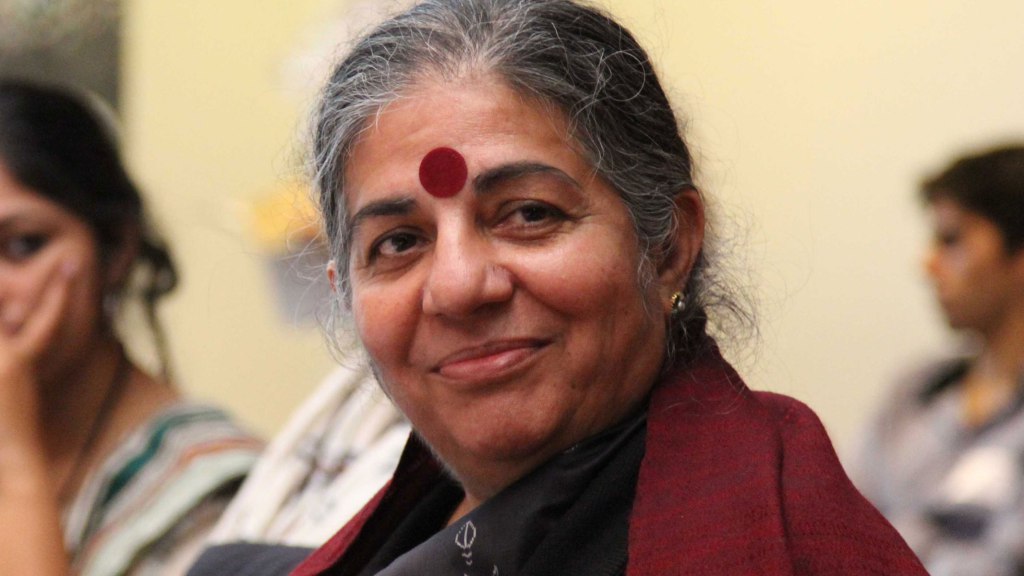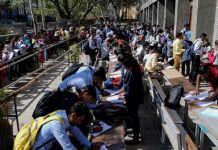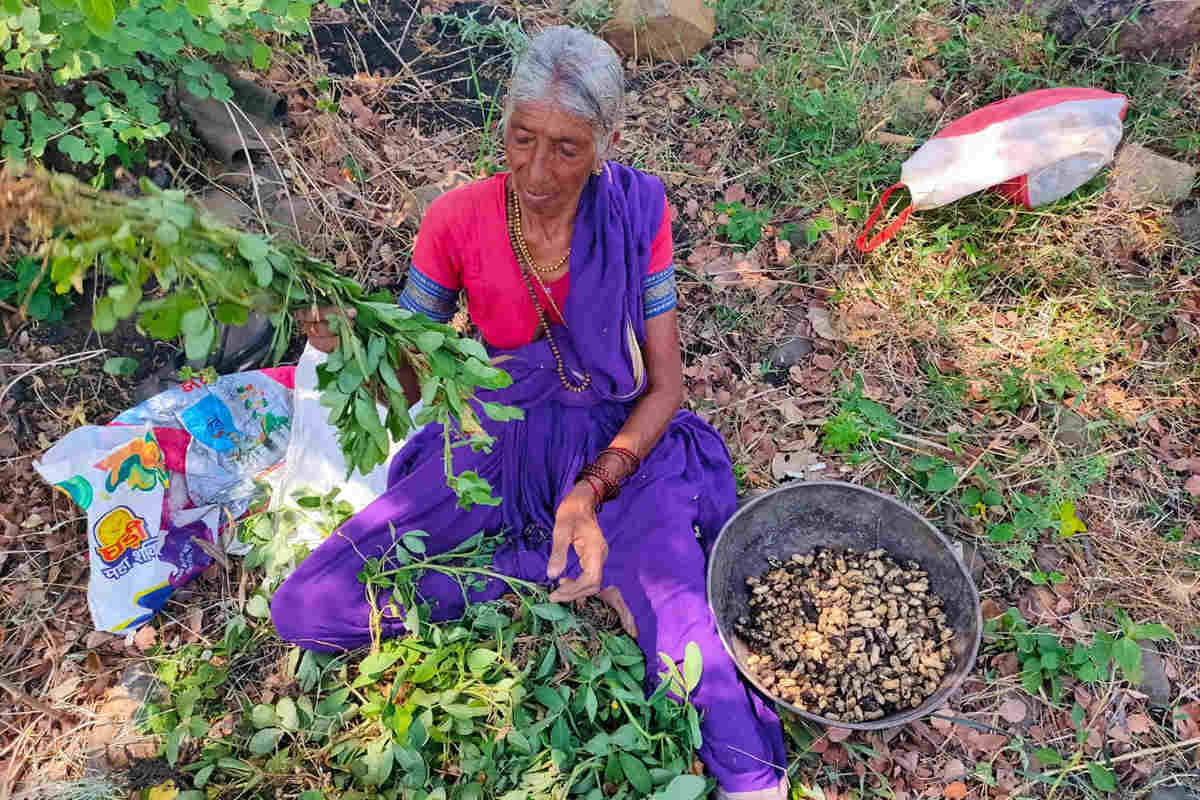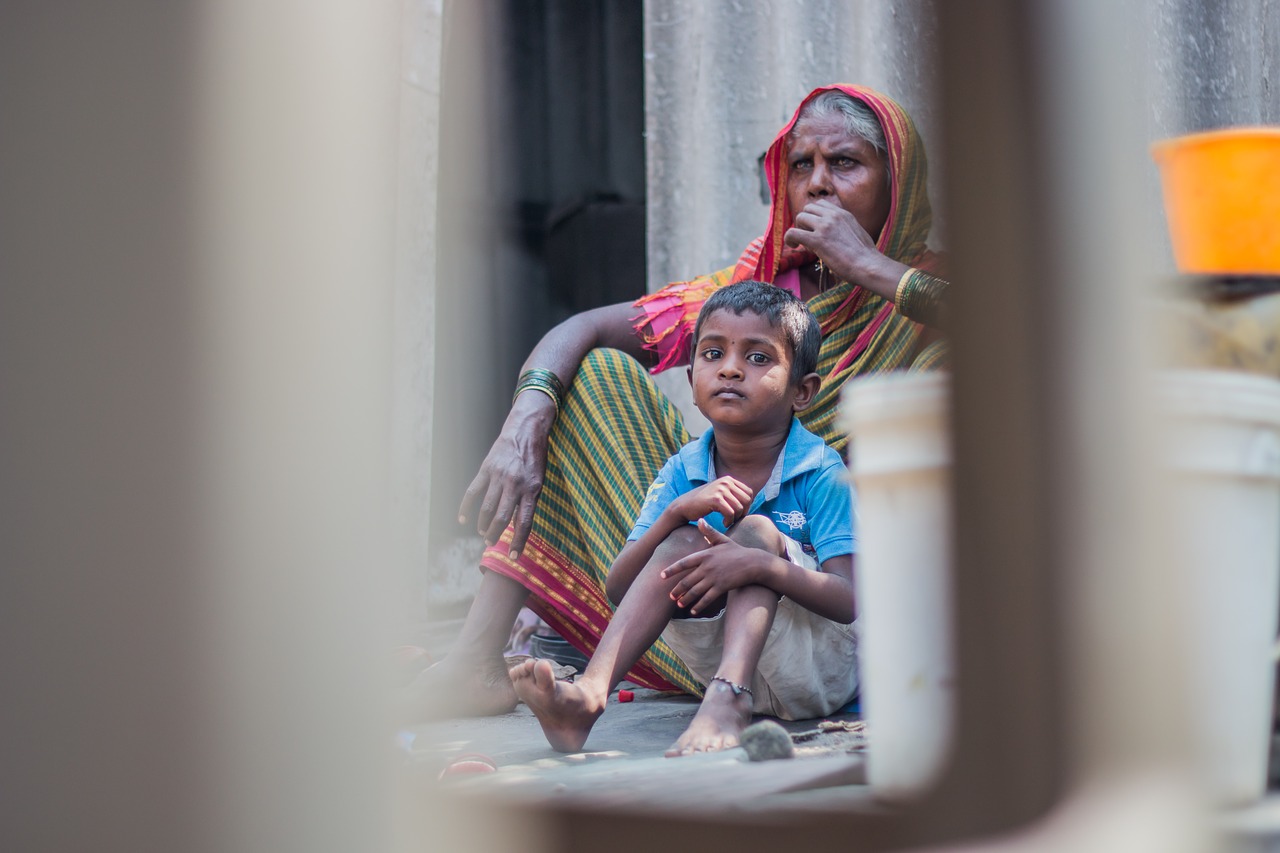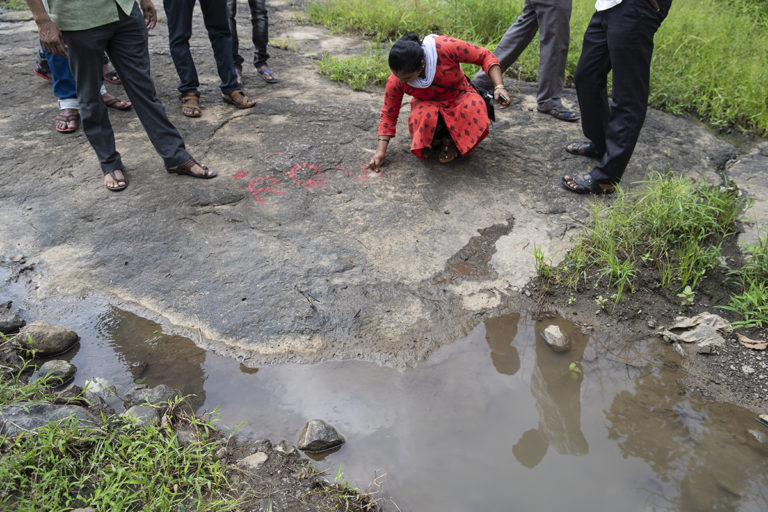
In Palghar and Bhiwandi, two distinct urban districts close to the financial capital Mumbai in the western state of Maharastra, politicians have skipped the customary pre-election visits, in advance of the state’s legislative assembly elections, scheduled for October 21.
Both the ruling dispensation and the opposition want to avoid farmers and tribal people in these districts, who are protesting against their lands being usurped by the government for the National Democratic Alliance (NDA) government’s dream project – the Mumbai-Ahmedabad bullet train project.
“Our land is our mother and our whole life depends on it. We won’t give it to anyone and won’t even allow the survey for the bullet train project in our villages. If our land is lost we will lose everything. We can’t help in fulfilling this government’s dream of the bullet train,” Kanchan Katkar, who was the head of the council of Mahagaon village for over 10 years, told Mongabay-India.
Mahagaon village is in Palghar district of Maharashtra where the land is scheduled to be acquired for the bullet train project. The village is just about 100 kilometres from Mumbai and several kilometres away from the national highway, nestled between small hills and miles of lush green fields.
Palghar is a fifth schedule area under the Indian constitution and that ensures proper protection to the rights of tribal people of that area. About 40 percent of the population of the district belongs to the tribal community, who have small land holdings and are dependent on other small jobs besides agriculture to run their lives.

“Elections or no elections it doesn’t matter to us. No political leader has come to us so far and even if someone comes we won’t let them allow it. We have tried to promote people from amongst us to fight elections but once they join a political party they forget the community. We are clear that we are ready to lose our lives but not our land,” said Ketkar, while she was flanked by dozens of other women who took a break from their work while she was showing the expected bullet train route that will pass through their lush green fields, local pastoral land and community land.
Elections to 288-member Maharashtra legislative assembly are scheduled to take place on October 21, 2019, and the counting of votes would take place on October 24. Palghar is one of the constituencies and is currently represented by the regional party Shiv Sena.
The bullet train project is the pet project of Prime Minister Narendra Modi and the project’s estimated cost is about Rs. 1.08 trillion (Rs. 108,000 crore). Of the total cost, about 81 percent of the project cost (Rs. 880 billion/Rs. 88,000 crore) is being provided by the Japan International Cooperation Agency (JICA) as a soft loan.
The route planned for the project will connect Maharashtra’s capital and the country’s financial centre Mumbai, with Ahmedabad. It involves a dedicated track of approximately 508 kilometres passing through Maharashtra (~156 kilometres), Gujarat (~351 kms) and Dadra and Nagar Haveli (two kms), including a seven-kilometre undersea tunnel in Thane Creek. It is envisaged to have a total of 12 stations on the route – Mumbai, Thane, Virar, Boisar, Vapi, Bilimora, Surat, Bharuch, Vadodara, Anand, Ahmedabad, Sabarmati.
The project is targeted to be completed by December 2023. According to the government’s own data, till July 2019, 548 hectares of land has been acquired out of the total requirement of approximately 1,380 hectares.
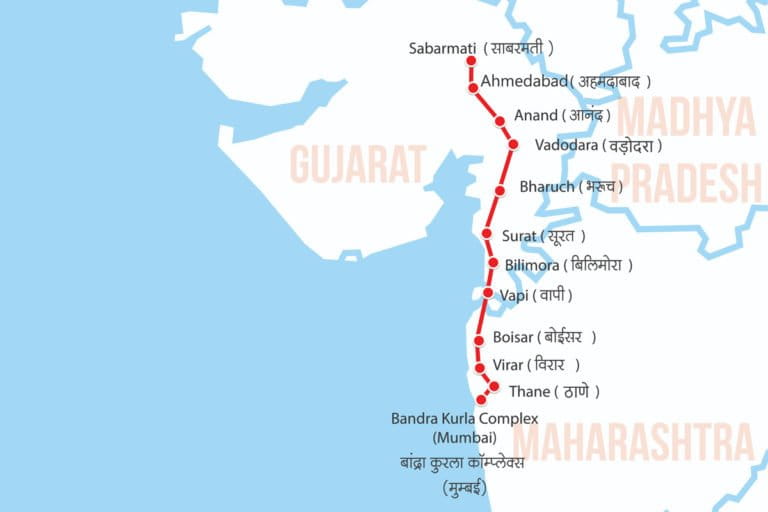
Fair compensation and transparency
Meanwhile, about 90 km away from the greenery of Palghar, in Bhiwandi district, known primarily for its textile industries, the villages have also been earmarked for the bullet train line. Their grouse though is the lack of transparency and fair compensation.
Arvind Mhatre, a farmer of Dive Anjur village in Bhiwandi area told Mongabay-India, “We have no issues with this dream project of Modiji’s but our problem is that we have been kept in the dark for too long. Several people in my village are losing the land to the bullet train project and notice for surveying the land was given nearly a year ago. Since then, there has been no communication and we have no information. Neither the bullet train authorities nor the state government has spoken to us about how land will be taken or how much will we be compensated. We are not against the project or development but we just want fair compensation and jobs. But if the government cheats us then we will have no option but to immolate ourselves.”
As Mhatre and his fellow villagers drive down in several cars, including an SUV, to meet Mongabay-India, there is an evident difference from their counterparts in Palghar. Most of the farmers whom Mongabay-India met at Bhiwandi have bigger land holdings as compared to those in Palghar. There was a clear difference in their houses as well. Compared to Palghar, where most of the houses are built from mud or from locally sourced tree branches, the houses in the impacted area in Bhiwandi are modern concrete structures.
However, the attachment to the land of their ancestors and the displeasure with losing it to the bullet train project is common among the two areas.
Mhatre is quick to dispel any impression of them being from well-to-do families, stating that they own nothing beyond their land — which if lost will spell doom for them.
Mhatre and others highlighted that for their area in Bhiwandi, which is on the outskirts of one of Asia’s costliest real estate regions and just a few hundred metres away from a national highway, an industrial area and big real estate projects, the compensation they are rumoured to get in lieu of their land is a pittance.
“This is the land of our ancestors. We are being threatened that if we don’t stop our opposition to this then not only our land will be acquired but it will be taken at a lower rate. But interestingly, till date, we do not know what is the rate that is even being offered to us. If this exploitation and force continues against us then we have decided that we and our families will self-immolate,” said Mhatre.

Mhatre and his friends emphasised that the sitting legislators have completely washed their hands off the issue and they just state that they have no information about it as they know it is PM’s dream project and any word against it could cost them. The constituencies in Bhiwandi are currently represented by BJP and Shiv Sena in the state assembly.
Mhatre’s fellow villagers Pravin Mhatre and Jitesh Patil, pointed to the small pillars (erected by bullet train authorities to mark the route) in knee-deep grass in fields and said that for them this blatant snatching of their land will be an important issue in the assembly elections as, despite repeated requests, their leaders have done nothing to address their concerns.
Tribal people and farmers up against the government
All along the route, the tribal communities and farmers have been protesting against the project. While some do not want to give up their land, others are seeking better compensation in lieu of giving up their land.
However, farmers in some villages in Bhiwandi and Palghar have reportedly given up their land for the project and the NHSRCL expects most of the land acquisition to be completed by the end of the year.
At many of the places, the villagers have not allowed the police and the authorities to conduct a ground survey for the bullet train project. Several villagers have thrown away the red erected markings (erected by authorities) or covered the red paint on stone or pillars used to show the route of the bullet train. The villagers stressed that it is both to throw a spanner in the work of the authorities as well as highlight their anger.
Ketkar and many other women of the tribal area in Palghar have found a way to deter police and authorities from entering their area. They have formed groups of women and whenever police or authorities try to enter their village they drive them away. “It is because if men protest, the police would take them away. But with us women alone driving them away, we try to ensure that all of us stay together and fight together,” Ketkar said.
Indian government’s Minister of Railways Piyush Goyal recently admitted before parliament that there has been some resistance to the bullet train project.
“There has been some resistance limited to few locations in the project alignment. So far, joint measurement survey has been completed in 251 out of total 297 villages in the project alignment,” Goyal told parliament while replying to a query in June 2019.
“There has been some resistance to land acquisition, which is limited to few localised area. All efforts have been made to clarify the doubts regarding the compensation and other entitlements and project affected persons are being persuaded to give their consent for land acquisition,” Goyal told parliament in July 2019.
Maharashtra elections bring no hope to farmers and tribal people
It is estimated that 14,884 households and 37,394 trees (in forest and non-forest areas) are expected to be impacted by the project. The estimates also reveals that approximately 35 percent of the affected households fall in the vulnerable category, which includes cases where the head of the family is scheduled caste, scheduled tribe, widow, separated woman, single woman, disabled, below poverty level, and persons above 65 years of age with no immediate family members to support.
The activists who have been working in Maharashtra with farmers and tribal people explained that there is a pattern to this kind of non-inclusive development.
“In Palghar, there are so many developmental projects like a seaport, expressway, coastal highway, transmission lines and now bullet train. The whole Palghar area is an area dominated by scheduled tribes but these days it seems more like a district known for its developmental projects. The tribal people have lost their land in every project and the worst part is that they have not got justice, rehabilitation and compensation in any of them,” Shashi Sonawane of the Bhumiputra Bachav Andolan, who is working with tribal communities in Palghar, Maharashtra, told Mongabay-India.
“The tribal people of Palghar are losing their lives and culture to this kind of development, even as they have repeatedly spoken against this development which is leaving them behind. Even during elections, issues of India’s indigenous people are not of concern to anyone. Political candidates don’t even visit us or speak to us about issues that are of concern to us,” said Sonawane, while sitting under a tree with many of the men who have been repeatedly protesting against any move to survey their land for over a year now.
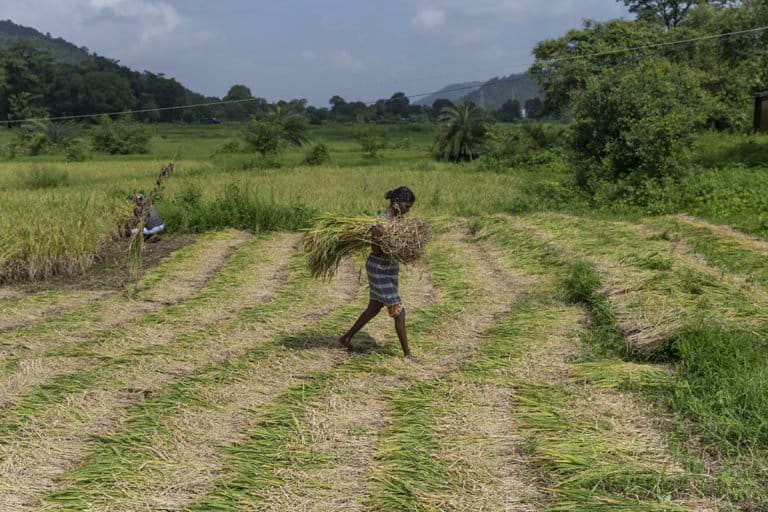
But it is not just the land that the farmers would be losing. According to the Ministry of Environment, Forest and Climate Change (MoEFCC) data, the project involves 131.302 hectare of forest land in Maharashtra and 5.847 hectare of forest land in Gujarat including 24.137 hectare of mangrove forest area. A total of 53,467 trees of mangrove are expected to be removed as part of the project. Till June 2019, an expenditure of about Rs 32 billion (Rs 3,226.8 crore) has been incurred on the project.
This article is republished from The Mongabay under a Creative Commons license. Read the original article.


